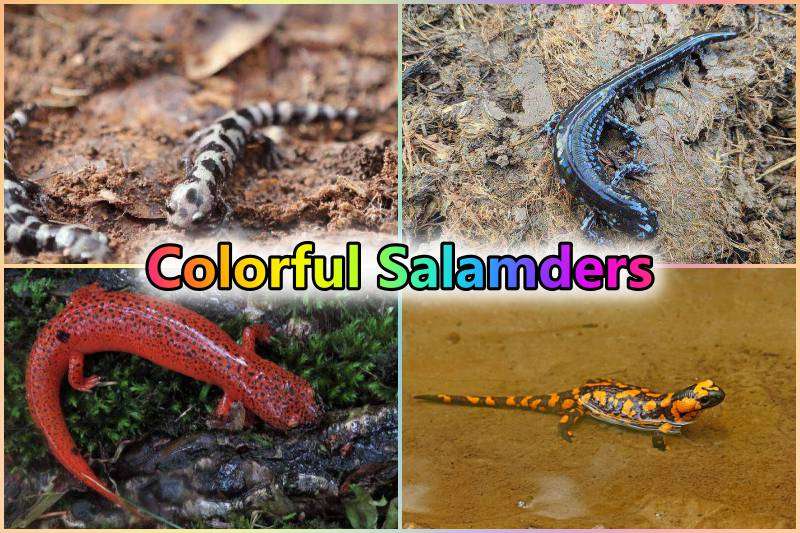Salamanders are a group of amphibians, like frogs. Except for Antarctica and Australia, they are found on every continent. Some dwell in wetlands and hide under rocks, whereas others live on the ground and hide in logs or reside in trees. They come in a variety of colors and sizes, but this article is focused on the 10 Most Colorful Salamanders in the world.
Salamanders have a wide range in terms of sizes; some could be as big as an adult human being, and some are so tiny that they can even sit on your finger. Some salamanders can be the color of rock or mud to disappear in the surrounding ground, and some can be brilliantly colored in bright red, green, and orange to warn off their predators and show cryptic coloration to blend in with their surroundings.
Do Salamanders Change Colors?
As It may seem like it, but no, salamanders are not able to regulate their colors or change colors like chameleons. Salamanders have a wide range of coloration throughout their lives; the color of Salamanders changes with age, temperature, climate, diet, and fear.
A recent research published by the University of Minnesota Morris stated: “how diet can affect coloration in Tiger Salamanders.”
Some specimens, such as tiger salamanders, become darker as they age or when attacked. While other specimens are lighter colored when in captivity, while outside, they tend to become darker.
10 Most Colorful Salamanders in the World
1) Southern Red backed Salamander
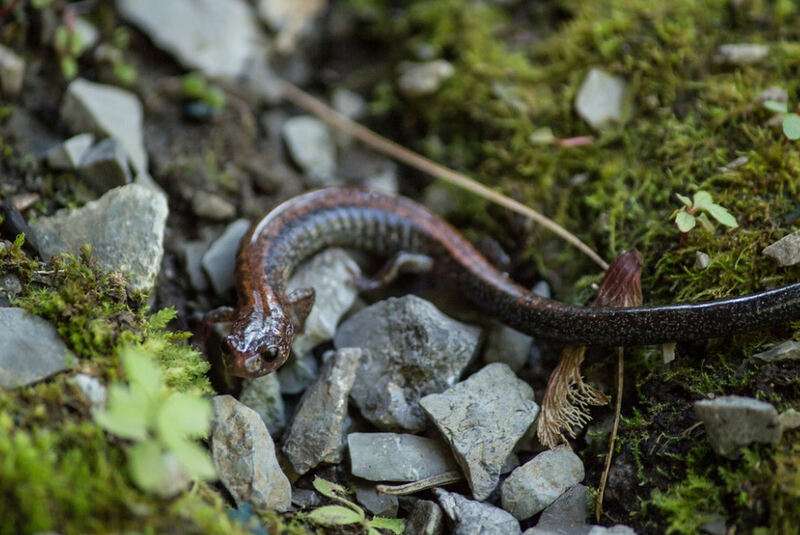
|
Common Name |
Southern Red Backed Salamanders |
|
Scientific Name |
Plethodon serratus |
|
Size |
8-11 cm (3-4 inch) |
|
Location |
The United States |
|
Diet |
Variety of Invertebrates, such as ants, mites, spiders, snails, beetles and insects |
Southern Red-backed Salamanders have a distinctive orangish-red broad stripe running from the snout down to the tail that is overlaid on a brown, glossy body.
Some specimens have serrated or saw-toothed edges on the band. They are a subspecies of Plethodon cinereus, the red-backed salamander.
Southern Red-backed Salamanders, on the other hand, come in a variety of colors and have more than two morphs; they are not always found in their red-backed phase; some specimens have olive grey or dark grey stripes in their lead-backed phase.
2) Green Salamander
|
Common Name |
Green Salamanders |
|
Scientific Name |
Aneides aeneus |
|
Size |
8–12 cm or (3 to 5 inch) |
|
Location |
Eastern half of the United States |
|
Diet |
Insects, beetles and other arthropods |
Green Salamanders are small, flat-bodied salamanders that are atypically colored. The skin of a Green Salamander is green with lichen-like blotches or markings on a darker black background.
Their body modifications, such as squared toe tips and long legs, are due to their adaptation for living on cliffs. They are commonly located in rock crevices.
3) Three-lined Salamanders
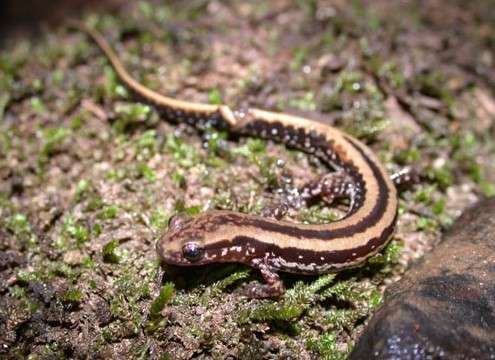
|
Common Name |
Three lined salamander |
|
Scientific Name |
Eurycea guttolineata |
|
Size |
10-15.9 cm (3-5 inch) |
|
Location |
Southeastern United States |
|
Diet |
Wide range of invertebrates |
Three-lined salamanders are average-sized salamanders with slender, tapering bodies and a long tail that is 23 of their total body length.
Three-lined Salamanders have three dark, bold-black longitudinal stripes or bars that run from their eyes down to their tails. They prefer streams on the outskirts of Cypress swamps and bottom-land hardwood plantations.
4) Blue Ridge Two-lined Salamander
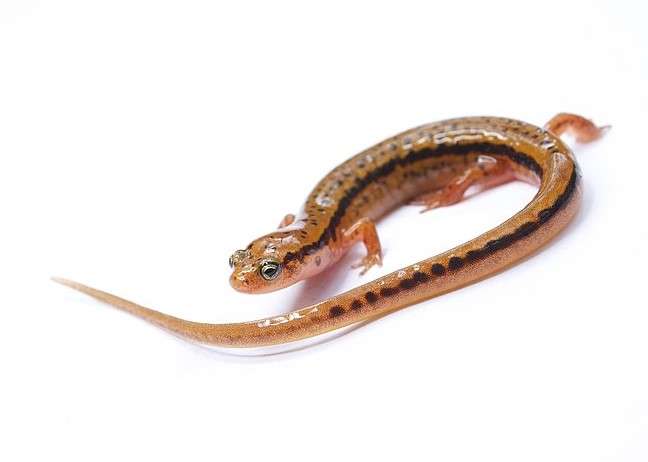
|
Common Name |
Blue Ridge two-lined salamander |
|
Scientific Name |
Eurycea wilderae |
|
Size |
2.75 – 3 in (7-10.7 cm) |
|
Location |
Southern Appalachian Mountains |
|
Diet |
Variety of Insects, midge larvae, nematodes and copepods |
Blue ridge Two-lined Salamanders are amazingly colored salamanders; they are strikingly yellowish or orange-colored with two notably dark stripes that might become patchier on the end, and black speckles are scattered on the dorsal portion.
The black stripes are outlined by contrasting yellow color markings, and their ventral side is completely yellow. The numbering of the coastal grooves differs in different specimens because of the different elevations at which they are found!
5) Blue Spotted Salamander
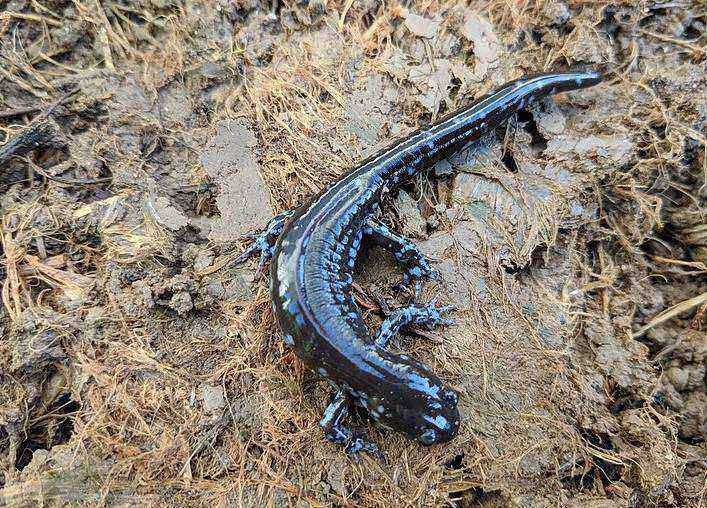
|
Common Name |
Blue-spotted salamander |
|
Scientific Name |
Ambystoma laterale |
|
Size |
10-14 cm (3.9-5.5 in) |
|
Location |
The Great Lakes states and Northeastern United States |
|
Diet |
Insects, snails, spiders, slugs, worms, centipedes, and other small invertebrates |
Blue spotted Salamanders are mid-sized, slim salamanders with rounded tails, and their skins are sooty black or blue-black with blue or white freckles or spots distributed all over their bodies. They spend most of the year hiding beneath leaf litter in underground caves.
Their courtship behaviors include an impressive “tail-fanning” display. Their favorable habitats are those of moist deciduous forests and swampy woodlands.
6) Marbled Salamanders
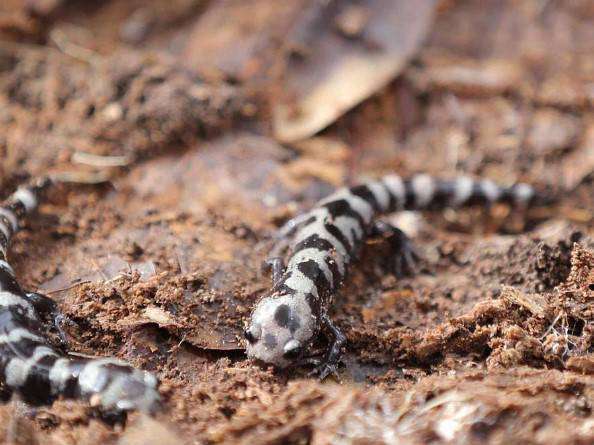
|
Common Name |
Marbled salamander |
|
Scientific Name |
Ambystoma opacum |
|
Size |
11 cm (4 inches) |
|
Location |
Eastern United States |
|
Diet |
Terrestrial invertebrates, such as worms, centipedes, insects, other arthropods, and mollusks, also feed on aquatic animals and crustaceans |
Marbled Salamanders are distinctively colored salamander species, and sexual dimorphism is shown with different coloration.
As their name suggests, they have marble-like color patterns; males have brilliant, bright white bands on black bodies, while females have whitish-grey bands; both of them have fully black bellies, and females of these species are larger than males.
Marbled Salamanders have poisonous glands on their tails that protect them from potential predators, but they are quite reclusive towards humans and run away if touched or handled, and they avoid any kind of human contact.
7) Fire Salamander
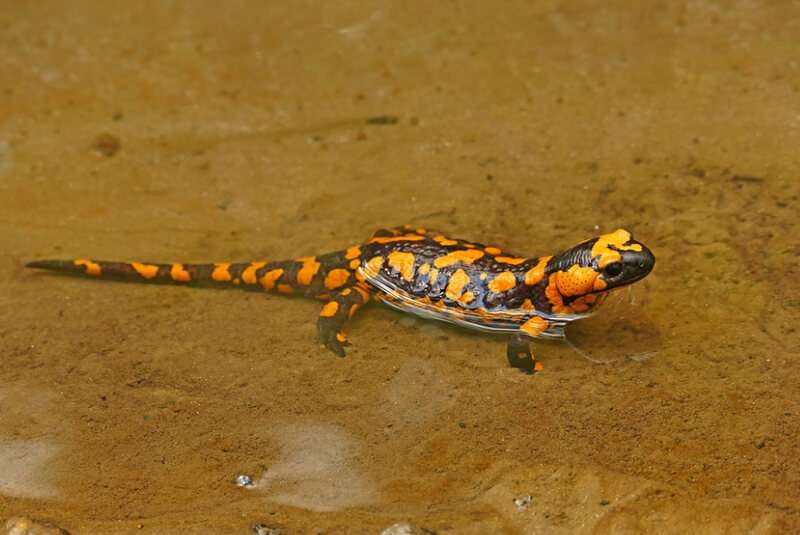
|
Common Name |
Fire salamanders |
|
Scientific Name |
Salamandra salamandra |
|
Size |
15–25 cm or (5.9–9.8 in) |
|
Location |
Europe |
|
Diet |
Insects, spiders, earthworms, centipedes, millipedes, slugs, and occasionally young frogs and newts |
Fire Salamanders have strikingly yellow or orange splotches on their black skin that resemble fire flames; ancient people had the belief that they were born out of fire because they have a tendency to hide under logs.
Their coloration varies to varying degrees in different specimens; some may be predominantly black, while others may be predominantly yellow. They supposedly have a vanilla fragrance, and their life span could be up to a splendid 50 years!
8) Red Salamanders
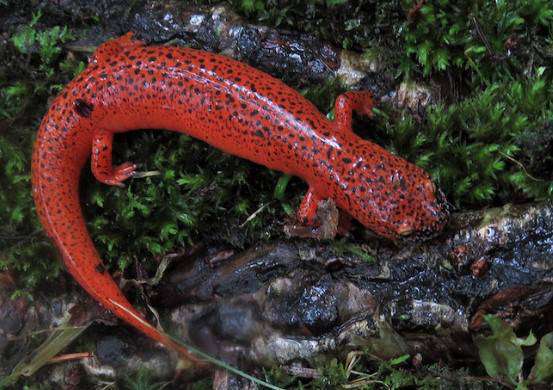
|
Common Name |
Red Salamanders |
|
Scientific Name |
Pseudotriton ruber |
|
Size |
11–18 cm or (4.3-7.1 inch) |
|
Location |
Eastern United States |
|
Diet |
Other smaller salamanders |
Red Salamanders are medium-sized salamanders that come in a variety of colors ranging from tan-yellow to orange to red.
They have a varying degree of black spots and markings on the dorsal side, which gives them a freckled look; as they age, their pigmentation becomes darker and the patterns on their skin diminish and look blurry.
Their bright coloration signifies their toxicity, and the secretion is extremely toxic and deadly for their predators.
Because they are adapted for living in streams and water bodies, they lack lungs and breathe through their skin. Their survival is aided by their lunglessness, as buoyancy would have endangered their lives.
9) Red Eft
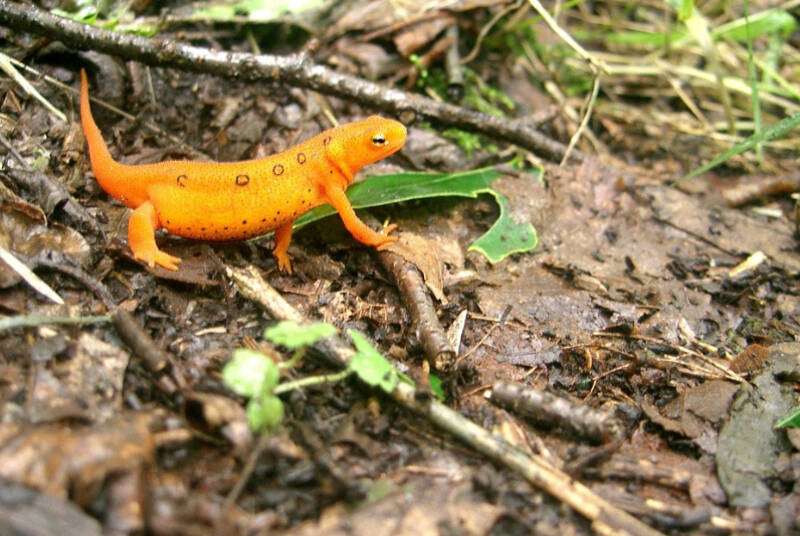
|
Common Name |
Red Eft (Eastern Newt) |
|
Scientific Name |
Notophthalmus viridescens |
|
Size |
13 cm or (5 inches) |
|
Location |
Eastern North America |
|
Diet |
Aquatic invertebrates, snails, worms, insects,mollusks, crustaceans,frog eggs and other young amphibians |
Red Eft are juveniles of the Eastern Newt, but they are more strikingly colored in bright reddish-orange and have a more rounded tail, while the Eastern Newts are beige-brown to olive green with a slightly flattened tail. Red efts can have up to 21-25 darker orange spots with tiny black specks.
They are one of the most common aquarium pets because of their eye-catching coloration; they are captured either from the wild or from the exotic pet market.
They eat every two or three days and secrete deadly toxins as defense mechanisms against predators.
10) Northern Slimy Salamander
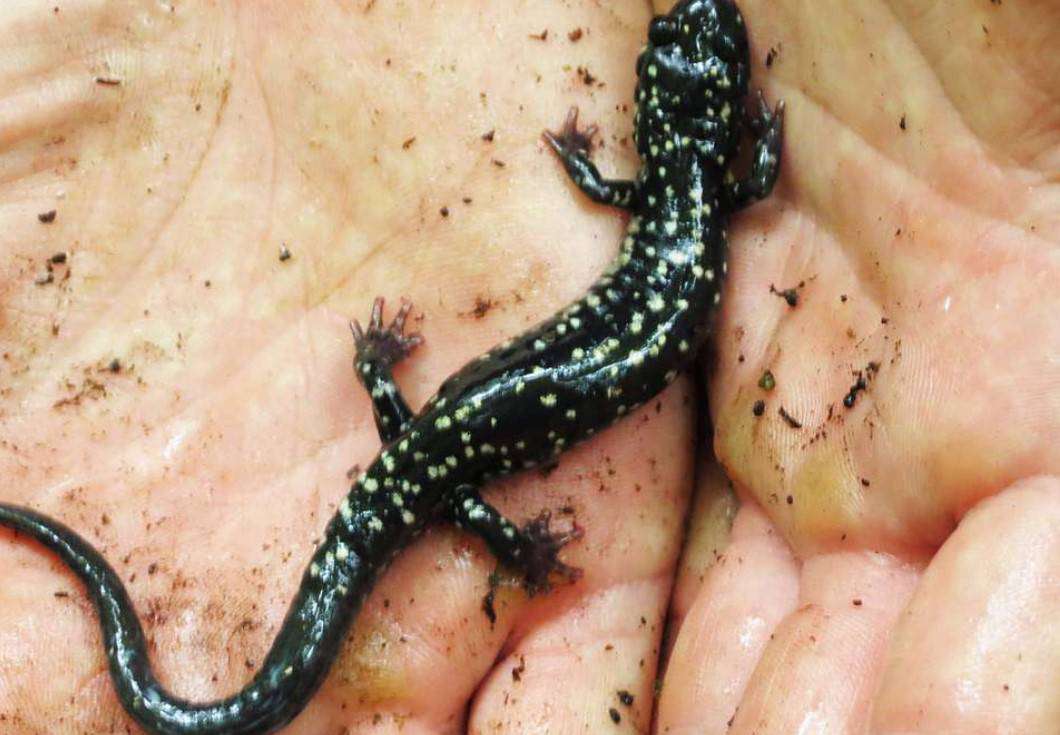
|
Common Name |
Northern slimy salamander |
|
Scientific Name |
Plethodon glutinosus |
|
Size |
12–17 cm or (4.7–6.7 inch) |
|
Location |
Eastern United States |
|
Diet |
Variety of invertebrates, as well as larval or adult insects |
Northern slimy Salamanders are referred to as “slimy” because of the sticky slime they secrete from the glands situated on their lower backs and tails to defend themselves against potential predators.
They have round spots on their dorsal side, which are more concentrated at the flanks and are present to varying degrees on the back, and they are dark black and shiny due to their secretions. They are nocturnal, appearing at dusk and disappearing as soon as dawn arrives.
Conclusion:
Salamanders are ideal pets for anyone who wants to pet an amphibian with bright colors and amazing features.
With some modifications and controlled set up, you can pet salamanders with fishes in an aquarium and they will live comfortably without creating any hassle. Some adorable salamanders such as Axolotl look really cute and would be perfect as pet salamanders! Here, we conclude our article.
Also Read:

Hey there! I’ve been the kid who used to love watching all the science stuff and that fascination lead me to choose Zoology as my Major in Graduation. I’m a self-taught writer and spend my time writing scintillating content on animals. I love observing animals behavior and their bond with humans. I want to give my point of view regarding animals i research about. I had done several projects on animals during my graduation and learned their behavior thoroughly.
